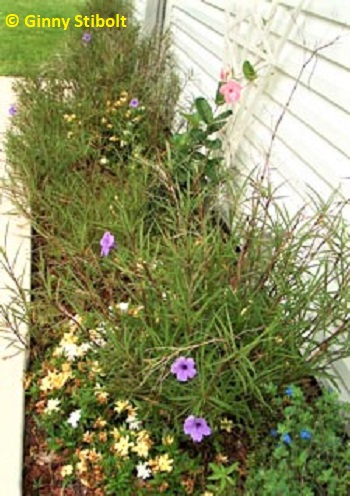Adventures of a Transplanted Gardener |
|||||
Troublesome spot? Convert to containers.
|
|||||
|
|
The L-shaped bed next to the garage, one of the more visible gardens as you drive up to our house, was a mess-under the eaves, no sprinkler coverage, and no drainage. The previous owner used a woven, low quality weed barrier with lava rocks and a questionable selection of plants. Every time it rained, the ground remained soaked and squishy for long periods, because the soil in the bed has such poor drainage. Worse, the old weed barrier had become a medium for various unwanted plants and weeds to grow in from above. So this messy, ineffective garden did not enhance the first impression of the house, and it was a maintenance nightmare.
We already knew that this garden needed help and we'd placed a big pot of Geraniums (Pelargonium x hortorum) in the center of the front of this L-shaped bed. Last fall we dug up the tropical Mandevilla (Mandevilla sanderi) from another bed to bring it in for the winter and placed its pot next to the trellis this spring.
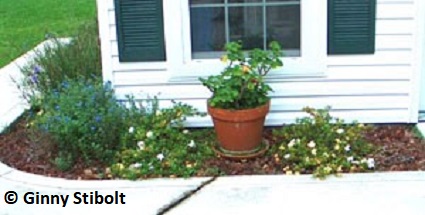
|
A trellis always looks better with a vine twining around it. Having the pot attached to the trellis for the season did complicate this project, as we had to work around it.
After removing the plants, the rocks, and the old weed barrier, we considered raising the bed a few inches. In the end, we decided that the lower level would actually work better, since containers add their own height.
Lost shrubs
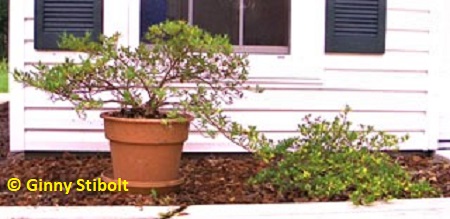 |
The previous owner had planted four compact Gardenias (Gardenia jasminoides 'Radicans'), but these little shrubs were lost in the low bed and were hiding under all those invasive Mexican Petunias (Ruellia simplex). We were pleasantly surprised that with just a little pruning, they looked like bonsais-perfect for container gardening. We put two into pots and the other two we used on either side of the back step. The photo of the two gardenias demonstrates the striking difference that potting these shrubs made.
Other problems
At the corner of the bed, a blue daze (Evolvulus glomeratus) hadn't been pruned properly and had a lot of die-back. Putting this into a pot means that we can bring it in for the winter, but meanwhile it's not ready for prime time. (Note: A member of the Morning Glory family, this plant's genus name refers to its non-climbing habit-untwining in Latin.)
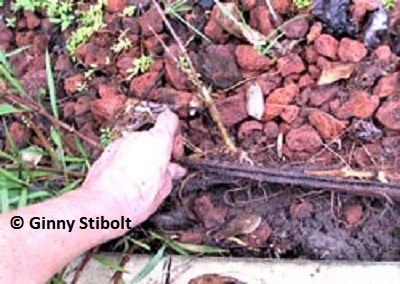 |
The worst problem, as noted in the opening paragraph, was the overall weediness. Scoffing at the old weed barrier, the Mexican petunias had taken over the whole side of this bed. This aggressive species is considered a Florida invasive. Don't plant it and pull it up when it appears. (Update: It took several years to get rid of it in our yard.)
Unlike the project with the French drains, removing all the plants made it easier to level and tamp down the whole bed. We put down a layer of heavy, professional grade, non-woven YardTek weed barrier and covered it with a thick layer of mulch. We considered reusing the lava rocks, but decided that since we'll be moving containers around the bed, that the sharp rocks would eventually compromise the weed barrier. (Update: the higher end cloth did not make one bit of difference. A few years later we ripped it all out. What a terrible waste of money and resources.)
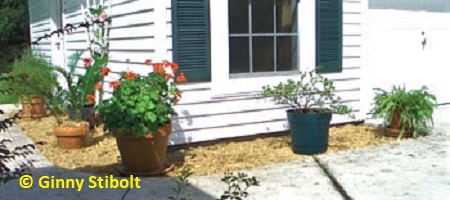 |
We need a few more pots to complete the arrangement, but each season we'll have the flexibility of putting the most attractive plants on display.
When working with containers here are several items to keep in mind:
-
The weight of each pot needs to be heavy enough so it doesn't blow over in a storm, but light enough so that you can move it without a forklift.
-
The plants must be able to tolerate hot soil and periodic drying. You can regulate some of this-clay pots will retain more heat and lose more water. The soil should be mixed with more or less organic material to suit the plant in that pot. We used a clay pot with sandy soil for the Geraniums and a heavier soil and plastic pots for the gardenias.
-
Do a deep watering each time you water-water until it runs out the bottom of the pot. No matter what type of plant or pot, never put a layer of gravel or potsherds in the bottom. That coarse layer actually impedes drainage. To keep the soil from running through the drainage holes line the bottom with a layer of leaves or pine needles.
-
If you plant more than one species in a pot, be sure they have similar needs for sun, soil, and water.
(Update: A few years later, I not only ditched the weed barrier cloth, but also the containers and converted the bed next to the garage to a native wildflower garden. I wrote about my change in gardening philosophy in "Listening to your landscape.")
Ginny Stibolt is a life-long gardener, a botanist, a naturalist, and a garden writer. You may contact her or read more of her articles posted on her website: www.greengardeningmatters.com.
Copyright Ginny Stibolt


